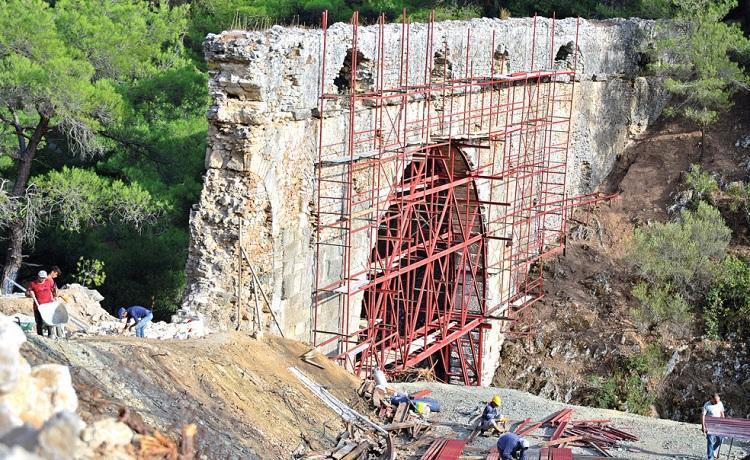Ancient aqueduct of Troy under restoration
ÇANAKKALE

A 3,500-year-old aqueduct in the ancient city of Troy in the northwestern province of Çanakkale is undergoing a restoration process.
Kemerdere Aqueduct, located near the Civler village of the center, was built during the Roman era as a water source for Troy, which has a history of more than 5,000 years. The restoration project has been prepared in order to pass down the historical building, which has been used for thousands of years and has been worn over time, to future generations.
With the support of the Southern Marmara Development Agency (GMKA), the restoration of the structure was initiated by the Special Provincial Administration.
Çanakkale Deputy Governor and Provincial Special Administration Abdullah Köklü told state-run Anadolu Agency that the structure was thoroughly examined during the project phase, and the samples taken were analyzed to determine the materials to be used in the restoration.
Stating that a research excavation was carried out to find the foundation remains of the missing part of the structure under the control of the Troy Museum, Köklü said, “After the findings were presented to the conservation board, the implementation started with the completion of the previously destroyed part of the building. The missing cornice stones of the structure were replaced, and the construction of the aqueducts at the top level of the cornice was started. On the other hand, the joints were opened and filled. The original stone was used as much as possible in stone manufacturing. In the missing parts, a repair stone suitable for the original was used. The mortar was prepared according to the results of the analysis.”
Köklü said that the work will continue with the maintenance of the aqueduct and the upper water channel, facade cleaning, and joint manufacturing. He stated that the restoration is set to be completed in the middle of this year.
Professor Rüstem Aslan, a Çanakkale Onsekiz Mart University (ÇOMÜ) academic and the head of Troy ancient city excavation committee, said that Kemerdere is a very important historical water source for Troy.
Aslan said that the settlement of Troy, which started in 3,500 B.C., turned into a very rich city due to trade in the Bronze Age.
“We know from archaeological data that there was great destruction in 1,200 B.C. in Troy. Later, the importance of Troy gradually decreases due to the destruction of settlements in this period in the entire Mediterranean basin and some climatic changes.”
Aslan stated that especially after the Hellenistic period, after Alexander the Great’s Anatolian expedition, the Troy region came to the fore again and became a rich city.
Stating that this importance increased and progressed until the Byzantine period, Aslan said: “We know that the city’s water needs increased with the transformation of the region, whose population increased considerably during the Byzantine period, to an important settlement in Western Anatolia, and water was brought to the city, especially from areas eight and 10 kilometers away, through arches. We found these data during the recent excavations,”
“One of the most important finds here is the Roman-era Kemerdere Aqueduct. This historical structure has been studied scientifically in a very important way. It is a very skillfully-made aqueduct. With this structure, which is very far from Troy, we know that water was transported from Kemerköy and even Çamlıca region to Troy and its surroundings with small and large arches. It is of great importance as it is one of the intact aqueducts from the Roman period in Western Anatolia,” he said.
Pointing out that the projects in the region gained more importance after the “2018 Year of Troy,” Aslan said that in addition to the Troy Museum, the works in Troy Ruins, Arkeoköy, and Etnoköy, hiking route and other works in the national park, Kemerdere Aqueduct is a great addition to the cultural tourism of the region.
















